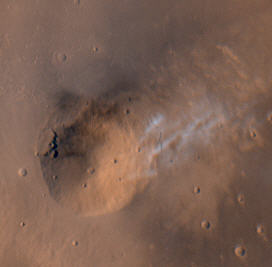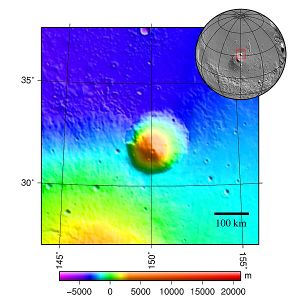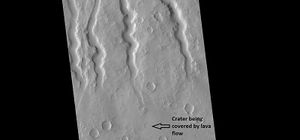Difference between revisions of "Hecates Tholus"
m |
|||
| (8 intermediate revisions by 2 users not shown) | |||
| Line 1: | Line 1: | ||
| − | [[Image:Hecates_Tholus.jpg|thumb|right|px|Hecates Tholus with [[cloud|clouds]]]]'''Hecates Tholus''' is a [[volcano]] in the | + | {{Mars atlas}} |
| + | [[Image:Hecates_Tholus.jpg|thumb|right|px|Hecates Tholus with [[cloud|clouds]]]]'''Hecates Tholus''' is a [[volcano]] in the Elysium Volcanic Region. | ||
[[Image:MOLA hecates tholus.jpg |thumb|left|px|Tographic map of area around Hecates Tholus]] | [[Image:MOLA hecates tholus.jpg |thumb|left|px|Tographic map of area around Hecates Tholus]] | ||
| − | Hecates is in the Cebrenia quadrangle. It is thought that the | + | |
| + | Hecates is in the [[Cebrenia quadrangle]]. The volcano is at location 32.12°N 150.24°E (209.76 W) and has a diameter of 182 km.<ref>https://planetarynames.wr.usgs.gov</ref> It is the northernmost of the Elysium volcanoes; the others are Elysium Mons and Albor Tholus. | ||
| + | |||
| + | ==Origin of name== | ||
| + | |||
| + | In planetary nomenclature, a "tholus" is a "small domical mountain or hill". Hecates is named after Hecate, the goddess of the ghost-world, nightly events, and sorcery.<ref>Blunck, J. 1982. Mars and its Satellites. Exposition Press. Smithtown, N.Y.</ref> | ||
| + | |||
| + | ==Glaciers== | ||
| + | |||
| + | It is thought that the caldera may have had glaciers in the past.<ref>http://www.msnbc.msn/id/7209308</ref> Some valleys on Hecates show a parallel drainage pattern.<ref>Hugh H. Kieffer 1992. Mars. University of Arizona Press. ISBN 978-0-8165-1257-7.</ref> Using the High Resolution Stereo Camera onboard ESA's Mars Express that is orbiting Mars, a team of researchers discovered evidence of a large explosive eruption and recent glaciers on the volcano. Although some of the ice has sublimated into the atmosphere, the authors believe there still exists ice under a cover of debris. They state the ice could be "accessible for automated or human exploration."<ref>Hauber, E., et al. 2005. Discovery of flank caldera and very young glacial activity at Hecates Tholus, Mars. Nature: 434, 356-361.</ref> On Earth 8 million year old ice is still present in the Antarctic dry valleys under a layer of dirt.<ref>Marchant, D., et al. 2002. Formation of patterned ground and sublimation till over Miocene glacial ice in Beacon Valley, southern Victoria Land, Antarctia. Geol. Soc. Am. Bull. 114, 718-730.</ref> | ||
| Line 11: | Line 21: | ||
<references/> | <references/> | ||
| − | + | [[Category:Mars Atlas]] | |
Latest revision as of 18:45, 8 January 2020

Hecates Tholus is a volcano in the Elysium Volcanic Region.
Hecates is in the Cebrenia quadrangle. The volcano is at location 32.12°N 150.24°E (209.76 W) and has a diameter of 182 km.[1] It is the northernmost of the Elysium volcanoes; the others are Elysium Mons and Albor Tholus.
Origin of name
In planetary nomenclature, a "tholus" is a "small domical mountain or hill". Hecates is named after Hecate, the goddess of the ghost-world, nightly events, and sorcery.[2]
Glaciers
It is thought that the caldera may have had glaciers in the past.[3] Some valleys on Hecates show a parallel drainage pattern.[4] Using the High Resolution Stereo Camera onboard ESA's Mars Express that is orbiting Mars, a team of researchers discovered evidence of a large explosive eruption and recent glaciers on the volcano. Although some of the ice has sublimated into the atmosphere, the authors believe there still exists ice under a cover of debris. They state the ice could be "accessible for automated or human exploration."[5] On Earth 8 million year old ice is still present in the Antarctic dry valleys under a layer of dirt.[6]
References:
- ↑ https://planetarynames.wr.usgs.gov
- ↑ Blunck, J. 1982. Mars and its Satellites. Exposition Press. Smithtown, N.Y.
- ↑ http://www.msnbc.msn/id/7209308
- ↑ Hugh H. Kieffer 1992. Mars. University of Arizona Press. ISBN 978-0-8165-1257-7.
- ↑ Hauber, E., et al. 2005. Discovery of flank caldera and very young glacial activity at Hecates Tholus, Mars. Nature: 434, 356-361.
- ↑ Marchant, D., et al. 2002. Formation of patterned ground and sublimation till over Miocene glacial ice in Beacon Valley, southern Victoria Land, Antarctia. Geol. Soc. Am. Bull. 114, 718-730.








